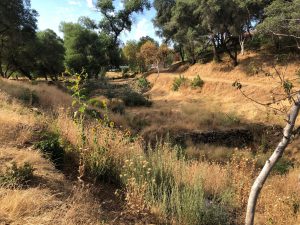Sonora had the oven turned on in July, 20 days over 100 degrees and eleven days above 90 degrees. Two days maxed out at 109 degrees. The whole area baked with few winners of the summer baking contest. People, homes, animals, air conditioning units, and even plants suffered.
The plant world did have some tough survivors that won their way through the heat; they not only hung on but continued flowering. Those blooms, even at their heat induced slow down, were still eye catching.
Some like it hot! Lantana enjoys dry heat but should be considered an annual where there is snow. Dark green leaves and brightly colored flowers enjoy the heat like a sunbather. Color combinations include reds, orange, yellow, white, pink, salmon, lavender, and purple. The flowers have a mild fragrance that is attractive to pollinators, hummingbirds, and butterflies. You may worry about deer predation, but the toxic nature of lantana should be a deterrent. That same toxicity means lantana should be planted away from children and pets.
Lantana will be a growth overachiever. Winter pruning helps stop trailing L. montevidensis from climbing your fence and heading over to the neighbors. Hybrid varieties are either Lantana camara, which is dwarf sized, or Lantana montevidensis, which is trailing or weeping. The bright colored flowers, called umbels, will bloom year-round in a protected area or moderate temperature. Lantana is not fussy. It wants a sunny spot with hot conditions and regular watering in well-drained soil.
Another tougher than tough heat lover is lavender, growing strong and living longer in fast draining, poor soil. Beautiful, silvery foliage plays well against any other green foliage. Flowers range from white, pink, lavender, and purple colors blooming several times during the heat of summer. To control size, plan on pruning back one third in January to keep the plant bushy and stop the center from dying back.
Lavender scent has been relied upon for thousands of years. The word lavender comes from the Latin root that means to wash. Lavender scent is used in soaps, laundry detergent, and shampoos. Lavender is important for its calming properties, soothing insomnia and anxiety. Lavender has the added value of repelling those mean mosquitos. A plant that appreciates heat and provides answers for what ails you is a winner.
The heat wave has highlighted tough plants with the ability to survive baking temperatures with adequate water. Canna lily, salvia, gerbera daisy, geranium, penstemons, Echinacea or coneflower, and Lily of the Nile all came through with little damage.
When choosing specimens for fall planting, try extending your anti-inflation shopping methods. Look for plants with high survival rates in both heat and cold. Plants that appreciate well-draining soil will help ease the most frequent killer of plants, overwatering. Look for plants that bloom and provide beauty in adverse conditions. Look for plants that will stand strong next to Jim Cantore of the Weather Channel. Choose plants that provide value by being tougher than tough.
Julie Silva is a University of California Cooperative Extension master gardener in Tuolumne County. UCCE Central Sierra master gardeners can answer your gardening questions.

